Vedda
The Vedda (Sinhala: වැද්දා [ˈvædːaː], Tamil: வேடர் Vēdar) or Wanniyalaeto[4] are a minority indigenous group of people in Sri Lanka who, among other sub-communities such as Coast Veddas, Anuradhapura Veddas and Bintenne Veddas,[5] are accorded indigenous status. The Vedda minority in Sri Lanka is in threat of becoming completely assimilated.[6] Most speak Sinhala instead of their indigenous languages which are nearing extinction. It has been hypothesized that the Vedda were probably the earliest inhabitants of Sri Lanka and have lived on the island since before the arrival of other ethnic groups in India.[7][8]
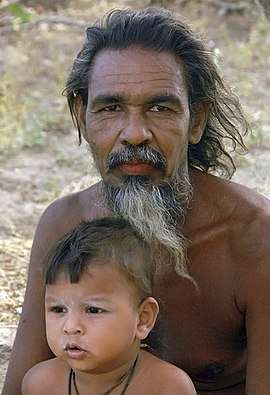 Vedda man and child. | |
| Total population | |
|---|---|
| Between 2,500 - 6,600[1][2] (less than 0.20% of the population) (2001)[3] | |
| Regions with significant populations | |
| Sri Lanka 2,500 (2002) | |
| Languages | |
| Vedda, Sinhala, Sri Lankan Tamil | |
| Religion | |
| Traditional animistic beliefs with Buddhism, Hinduism[1] | |
| Related ethnic groups | |
| Sinhalese |
Veddas are also mentioned in Robert Knox's history of his captivity by the King of Kandy in the 17th century. Knox described them as "wild men", but also said there was a "tamer sort", and that the latter sometimes served in the king's army.[9]
The Ratnapura District, which is part of the Sabaragamuwa Province, is known to have been inhabited by the Veddas in the distant past. This has been shown by scholars like Nandadeva Wijesekera. The very name Sabaragamuwa is believed to have meant the village of the Sabaras or "forest barbarians". Place-names such as Vedda-gala (Vedda Rock), Vedda-ela (Vedda Canal) and Vedi-Kanda (Vedda Mountain) in the Ratnapura District also bear testimony to this. As Wijesekera observes, a strong Vedda element is discernible in the population of Vedda-gala and its environs.
Etymology
Ethnonyms of Vedda include Vadda, Veddah, Veddha and Vaddo.[5] "Vedda" is either a Dravidian word and stems from Tamil word Vēdu meaning hunting,[5][10][11] or from Sanskrit vyādha ("hunter") or veddhṛ ("the one who pierces").[12]
Population affinities
Anthropology
The Vedda are often seen as the native population of Sri Lanka. A 2011 study on dental characteristics suggested a close relation between Vedda and other South Asians as well as to western Eurasian populations.[13] A 2012 study on crania showed the Vedda to have close affinities with other South Asian populations such as other Sri Lankans, South Indians, and Punjabis (which had been classified as having Caucasoid affinities) and to differ significantly from Andaman islanders.[14]
A 2013 craniometric study by Raghavan et al. showed that the Vedda are closely related to other groups in Sri Lanka and India, especially to Sinhalese and Tamils, and also indicated deep relations between South Asian populations and the modern populations of Europe, the Middle East and North Africa. According to Raghavan et al. the cranial characteristics of the Vedda are closest to other South Asians and distinct from “Australo-Melanesians”. Raghavan et al. also, while also noting the distinctiveness of between South Asian (including Vedda) and Andamanese crania, explain that this is not in conflict with genetic evidence showing a partial common ancestry (a non-West Eurasian component known as "Ancestral South Indian" or "ASI") and genetic affinity between South Asians and the native Andamanese (who are sometimes classified as Australo-Melanesians), stating that "The distinctiveness of Andamanese and southern Indian crania need not challenge the finding by Reich et al. for an “Ancestral South Indian” ancestry shared by southern Indians and Andamanese", and that the differences may be in part due the greater craniometric specialization of South Asians compared to Andamanese.[15]
Genetics
Groups ancestral to the modern Veddas were probably the earliest inhabitants of Sri Lanka. Their arrival is dated tentatively to about 40,000–35,000 years ago. They show a relationship with other South Asian and Sri Lankan populations, but are genetically distinguishable from the other peoples of Sri Lanka, and show a high degree of intra-group diversity. This is consistent with a long history of existing as small subgroups undergoing significant genetic drift.[16][17]
In one study on maternal (mitochondrial DNA) haplogroups in Sri Lankan populations (the Vedda, Sri Lankan Tamil, and Sinhalese), the Vedda were found to carry predominantly haplogroups U and R and to carry maternal haplogroup M at about 17%, unlike the Tamil people and many mainland Indian tribal groups, among which haplogroup M is predominant. The Vedda people and Low-country Sinhalese showed frequencies of haplogroup R at 45.33 and 25%, respectively. The Vedda were found to be distinct but closer to Sinhalese than to other South Asian groups (including the Sri Lankan Tamils, who are believed to be of "more recent origin from the mainland" and less long-established in Sri Lanka than the Vedda or Sinhalese). It was determined in the study to be likely that the branches of haplogroups R and U "found to be particularly prevalent in the Vedda, were derived from ancestors on the Indian subcontinent."[17]
Another study on maternal haplogroups in Sri lankan groups (also the Vedda, Sri Lankan Tamil, and Sinhalese) found similar results, with the Vedda belonging predominantly to the mitochondrial haplogroup N (which "exists in almost all European, Oceanian, and many Asian and Amerindian populations.") and its subgroups U and R (with those comprising about two thirds of their maternal lineages), differing from other South Asian groups (such as the Sri Lankan Tamil, Sinhalese, and several Indian Tribal groups) among whom haplogroup M is predominant. The study also found that "South Asian (Indian) haplogroups were predominant" in the three Sri Lankan groups (including the Vedda) but that the Sinhalese, Sri Lankan Tamil, and Vedda populations also "had a considerable presence of West Eurasian haplogroups." One phylogenetic study on mitochondrial DNA hypervariable segments HVI and part of HVII showed the Vedda to be "genetically distinct from other major ethnic groups (Sinhalese, Sri Lankan Tamils and Indian Tamils) in Sri Lanka." Another study on alpha-2-HS-glycoprotein allele frequency showed the Veddas and Sinhalese to be more biologically related to each other than to most other ethnic groups in Asia.[18]
Language
.jpg)
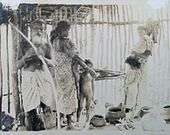
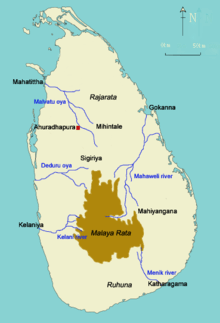
The original language of the Veddas is the Vedda language, which today is used primarily by the interior Veddas of Dambana. Communities such as Coast Veddas and Anuradhapura Veddas, who do not identify themselves strictly as Veddas, also use Vedda language for communication during hunting and or for religious chants. When a systematic field study was conducted in 1959 it was determined that the language was confined to the older generation of Veddas from Dambana. In the 1990s, self-identifying Veddas knew few words and phrases in the Vedda language, but there were individuals who knew the language comprehensively. Initially, there was considerable debate among linguists as to whether Vedda is a dialect of Sinhala or an independent language. Later studies indicate that it diverged from its parent stock in the 10th century and became a Creole and a stable independent language by the 13th century, under the influence of Sinhala.
The parent Vedda language(s) is of unknown genetic origins, while Sinhala is of the Indo-Aryan branch of Indo-European languages. Phonologically it is distinguished from Sinhala by the higher frequency of palatal sounds C and J. The effect is also heightened by the addition of inanimate suffixes. Vedda language word class is morphologically divided into nouns, verbs and variables with unique gender distinctions inanimate nouns. Per its Creole tradition, it has reduced and simplified many forms of Sinhala such as second person pronouns and denotations of negative meanings. Instead of borrowing new words from Sinhala, Vedda created combinations of words from a limited lexical stock. Vedda also maintains many archaic Sinhala terms prior to the 10th to 12th centuries, as a relict of its close contact with Sinhala. Vedda also retains a number of unique words that cannot be derived from Sinhala. Likewise, Sinhala has also borrowed from the original Vedda language, words, and grammatical structures, differentiating it from its related Indo-Aryan languages. Vedda has exerted a substratum influence in the formation of Sinhala.
Veddas that have adopted Sinhala are found primarily in the southeastern part of the country, especially in the vicinity of Bintenne in Uva Province. There are also Veddas that have adopted Sinhala who live in Anuradhapura District in the North Central Province.[19][20]
Another group, often termed East Coast Veddas, is found in coastal areas of the Eastern Province, between Batticaloa and Trincomalee. These Veddas have adopted Tamil as their mother tongue.[21][22]
Cultural aspects
Language
The parent of Vedda language is of unknown linguistic origin and is considered a language isolate. Early linguists and observers of the language considered it to be either a separate language or a dialect of Sinhala. The chief proponent of the dialect theory was Wilhelm Geiger, but he also contradicted himself by claiming that Vedda was a relexified aboriginal language.[23]
Veddas consider the Vedda language to be distinct from Sinhala and use it as an ethnic marker to differentiate them from Sinhalese people.[24]
Religion
The original religion of Veddas is animism. The Sinhalized interior Veddahs follow a mix of animism and nominal Buddhism; whereas the Tamilized east coast Veddahs follow a mix of animism and nominal Hinduism with folk influences among anthropologists.
One of the most distinctive features of Vedda religion is the worship of dead ancestors, who are called "nae yaku" among the Sinhala-speaking Veddas and are invoked for the game and yams.[25] There are also peculiar deities unique to Veddas, such as "Kande Yakka".[26]
Veddas, along with the Island's Buddhist, Hindu and Muslim communities, venerate the temple complex situated at Kataragama, showing the syncretism that has evolved over 2,000 years of coexistence and assimilation. Kataragama is supposed to be the site where the Hindu god Skanda or Murugan in Tamil met and married a local tribal girl, Valli, who in Sri Lanka is believed to have been a Vedda.[27]
There are a number of less famous shrines across the island which are sacred to the Veddas as well as to other communities.[27]
Rituals
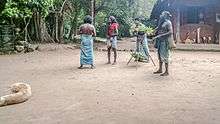
Vedda marriage is a simple ceremony. It consists of the bride tying a bark rope (Diya lanuva) that she has twisted, around the waist of the groom. This symbolizes the bride's acceptance of the man as her mate and life partner. Although endogamous marriage between cross-cousins was the norm until recently, this has changed significantly, with Vedda women even contracting marriages with their Sinhalese and Moor neighbors.
In Vedda society, women are in many respects men's equals. They are entitled to similar inheritance. Monogamy is the general rule, though a widow would frequently marry her husband's brother as a means of support and consolation (levirate marriage). They also do not practice a caste system.[28]
Death, too, is a simple affair without ostentatious funeral ceremonies where the corpse of the deceased is promptly buried.
Burial
Since the opening of colonization schemes, Vedda burials changed when they dug graves of 4–5 feet deep and wrapped the body wrapped cloth and covered it with leaves and earth. The Veddas also laid the body between the scooped out trunks of the gadumba tree before they buried it. At the head of the grave were kept three open coconuts and a small bundle of wood, while at its foot were kept an opened coconut and an untouched coconut. Certain cactus species (pathok) were planted at the head, the middle and the foot. Personal possessions like the bow and arrow, betel pouch, were also buried. This practice varied by community. The contents of the betel pouch of the deceased were eaten after his death.
Cult of the dead
The Veddas practice a cult of the dead. They worshipped and made incantations to their Nae Yakka (Relative Spirit) followed by another customary ritual (called the Kiri Koraha) which is still in vogue among the surviving Gam Veddas of Rathugala, Pollebedda Dambana and the Henanigala Vedda re-settlement (in Mahaweli systems off Mahiyangane).
They believed that the spirit of their dead would haunt them bringing forth diseases and calamity. To appease the dead spirit they invoke the blessings of the Nae Yakka and other spirits, like Bilinda Yakka, Kande Yakka followed by the dance ritual of the Kiri Koraha.[29]
According to Sarasin Cousins (in 1886) and Seligmann's book - 'The Veddas' (1910).
"When man or woman dies from sickness, the body is left in the cave or rock shelter where the death took place, the body is not washed or dressed or ornamented in any way, but is generally allowed to be in the natural supine position and is covered with leaves and branches. This was formerly the universal custom and still persists among the less sophisticated Veddas who sometimes in addition place a large stone upon the chest for which no reason could be given, this is observed at Sitala Wanniya (off Polle-bedda close to Maha Oya), where the body is still covered with branches and left where the death occurred."
Clothing
%2C_RP-F-F80068.jpg)
Until fairly recent times, the raiment of the Veddas was remarkably scanty. In the case of men, it consisted only of a loincloth suspended with a string at the waist, while in the case of women, it was a piece of cloth that extended from the navel to the knees. Today, however, Vedda attire is more covering, men wear a short sarong extending from the waist to the knees, while the women clad themselves in a garment similar to the Sinhala diya-redda which extends from the breast line to the knees.
Music
Bori Bori Sellam-Sellam Bedo Wannita,
Palletalawa Navinna-Pita Gosin Vetenne,
Malpivili genagene-Hele Kado Navinne,
Diyapivili Genagene-Thige Bo Haliskote Peni,
Ka tho ipal denne
(A Vedda honeycomb cutter's folk song)
Meaning of this song - The bees from yonder hills of Palle Talawa and Kade suck nectar from the flowers and made the honeycomb. So why should you give them undue pain when there is no honey by cutting the honeycomb.
Livelihood
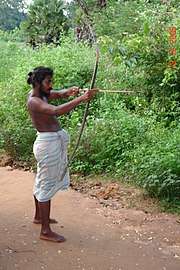
Veddas were originally hunter-gatherers. They used bows and arrows to hunt game, harpoons and toxic plants for fishing and gathered wild plants, yams, honey, fruit and nuts.[30] Many Veddas also farm, frequently using slash and burn or swidden cultivation, which is called "Hena" in Sri Lanka. East Coast Veddas also practice sea fishing. Veddas are famously known for their rich meat diet. Venison and the flesh of rabbit, turtle, tortoise, monitor lizard, wild boar and the common brown monkey are consumed with much relish. The Veddas kill only for food and do not harm young or pregnant animals. Game is commonly shared amongst the family and clan. Fish are caught by employing fish poisons such as the juice of the pus-vel (Entada scandens) and daluk-kiri (Cactus milk).

Vedda culinary fare is also deserving of mention. Amongst the best known are gona perume, which is a sort of sausage containing alternate layers of meat and fat, and goya-tel-perume, which is the tail of the monitor lizard (talagoya), stuffed with fat obtained from its sides and roasted in embers. Another Vedda delicacy is dried meat preserve soaked in honey. In the olden days, the Veddas used to preserve such meat in the hollow of a tree, enclosing it with clay.
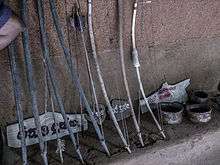
Such succulent meat served as a ready food supply in times of scarcity. The early part of the year (January–February) is considered to be the season of yams and mid-year (June–July) that of fruit and honey, while hunting is availed of throughout the year. Nowadays, more and more Vedda folk have taken to Hena (slash and burn) cultivation. Kurakkan Eleusine coracana is cultivated very often. Maize, yams, gourds and melons are also cultivated. In the olden days, the dwellings of the Veddas consisted of caves and rock shelters. Today, they live in unpretentious huts of wattle, daub and thatch.
In the reign of King Datusena (6th century CE) the Mahaweli ganga was diverted at Minipe in the Minipe canal nearly 47 miles long said to be constructed with help from the Yakkas. The Mahawamsa refers to the canal as Yaka-bendi-ela. When the Ruwanweli Seya was built in King Dutugemunu's time (2nd century BCE) the Veddas procured the necessary minerals from the jungles.
King Parakrama Bahu the great (12th century) in his war against the rebels employed these Veddas as scouts.
In the reign of King Rajasinghe II (17th century) in his battle with the Dutch he had a Vedda regiment. In the abortive Uva-Welessa revolt of 1817-1818 of the British times, led by Keppetipola Disawe, the Veddas too fought with the rebels against the British forces.
Current status
| Year | Pop. | ±% |
|---|---|---|
| 1881 | 2,200 | — |
| 1891 | 1,200 | −45.5% |
| 1901 | 4,000 | +233.3% |
| 1911 | 5,300 | +32.5% |
| 1921 | 4,500 | −15.1% |
| 1931 | 5,200 | +15.6% |
| 1946 | 2,400 | −53.8% |
| 1953 | 800 | −66.7% |
| 1963 | 400 | −50.0% |
| 1971 | — | |
| 1981 | — | |
| 1989 (est.) | — | |
| 2001 | — | |
| 2011 | — | |
| Source:Department of Census & Statistics[31] Data is based on Sri Lankan Government Census. | ||
Some observers have said Veddas are disappearing and have lamented the decline of their distinct culture.[20][32][33][34] Land acquisition for mass irrigation projects, government forest reserve restrictions, and the civil war have disrupted traditional Vedda ways of life.[20][32][35][36] Between 1977 and 1983 under the Accelerated Mahaweli Development Project and colonization schemes, approximately 51468 hectares were turned into a gigantic hydroelectric dam irrigation project.[32][37] Subsequently, the creation of the Maduru Oya National Park deprived the Veddhas their last hunting grounds.[37] In 1985, the Veddha Chief Thissahamy and his delegation were obstructed from attending the United Nations Working Group on Indigenous Populations.[37] Dr. Wiveca Stegeborn, an anthropologist, has been studying the Vedda since 1977 and alleges that their young women are being tricked into accepting contracts to the Middle East as domestic workers when in fact they will be trafficked into prostitution or sold as sex slaves.[38]
However, cultural assimilation of Veddas with other local populations has been going on for a long time. "Vedda" has been used in Sri Lanka to mean not only hunter-gatherers but also to refer to any people who adopt an unsettled and rural way of life and thus can be a derogatory term not based on ethnic group. Thus, over time, it is possible for non-Vedda groups to become Veddas, in this broad cultural sense.[39][40] Vedda populations of this kind are increasing in some districts.[41]
In zoology
A spider genus endemic to Sri Lanka was named Wanniyala as a dedication to Sri Lanka's oldest civilized people.[42]
See also
References
| Wikimedia Commons has media related to Vedda people. |
- http://www.encyclopedia.com/places/asia/sri-lankan-political-geography/vedda
- http://www.ethnologue.com/show_language.asp?code=ved
- Jayasuriya, S. de Silva (2000). The Portuguese Cultural Imprint on Sri Lanka. Lusotopie 2000. p. 255.
- "Evidence for persistent forest reliance by Indigenous peoples in historical Sri Lanka". www.shh.mpg.de. Retrieved 2020-02-08.
- "Vedda facts, information, pictures | Encyclopedia.com articles about Vedda". www.encyclopedia.com. Retrieved 2017-09-18.
- "Vedda tribe becoming extinct, Chandler's Ford Today". 2014-09-06.
- "Race in Sri Lanka: What genetic evidence tells us | the Sundaytimes Sri Lanka".
- Ranaweera, Lanka; Kaewsutthi, Supannee; Win Tun, Aung; Boonyarit, Hathaichanoke; Poolsuwan, Samerchai; Lertrit, Patcharee (2014). "Mitochondrial DNA history of Sri Lankan ethnic people: Their relations within the island and with the Indian subcontinental populations". Journal of Human Genetics. 59 (1): 28–36. doi:10.1038/jhg.2013.112. PMID 24196378.
- Knox, Robert [1681] (1981). A Historical Relation of Ceylon. Tisara Prakasakayo Ltd (page 195).
- Boyle, Richard (2004). Knox's Words: A Study of the Words of Sri Lankan Origin Or Association First Used in English Literature by Robert Knox and Recorded in the Oxford English Dictionary. Visidunu Publication. ISBN 9789559170679.
- "வேடன் | அகராதி | Tamil Dictionary". agarathi.com. University of Madras Lexicon. Retrieved 2017-09-18.
- Wilhelm Geiger: An Etymological Glossary of the Sinhalese Language. Colombo 1941
- Schug, Gwen Robbins; Walimbe, Subhash R. (2016-05-16). A Companion to South Asia in the Past. John Wiley & Sons. ISBN 978-1-119-05548-8.
- Kulatilake, Samanti. "Cranial Morphology of the Vedda people - the indigenes of Sri Lanka". Cite journal requires
|journal=(help) - Rathee, Suresh Kanta; Pathmanathan, Gayathiri; Bulbeck, David; Raghavan, Pathmanathan (2013). "Indian Craniometric Variability and Affinities". International Journal of Evolutionary Biology. 2013: 836738. doi:10.1155/2013/836738. PMC 3886603. PMID 24455409.
- Deraniyagala SU (September 1996). "Pre-and protohistoric settlement in Sri Lanka". XIII UISPP Congress Proceedings. 5: 277–285.
- Ranaweera L, Kaewsutthi S, Win Tun A, Boonyarit H, Poolsuwan S, Lertrit P (January 2014). "Mitochondrial DNA history of Sri Lankan ethnic people: their relations within the island and with the Indian subcontinental populations". Journal of Human Genetics. 59 (1): 28–36. doi:10.1038/jhg.2013.112. PMID 24196378.
- Ranasinghe, Ruwandi (2015). "A study of genetic polymorphisms in mitochondrial DNA hypervariable regions I and II of the five major ethnic groups and Vedda population in Sri Lanka" (PDF). Lay summary.
- Brow, James (1978). Vedda Villages of Anuradhapura. University of Washington Press.
- Nira Wickramasinghe. "Sri Lanka's conflict: culture and lineages of the past". Sri Lanka Guardian. Retrieved Feb 20, 2016.
- Sri Lanka's coastal Vedda indigenous communities
- East Coast Veddas
- Van Driem 2002, p. 227
- Dharmadasa 1974, p. 81
- Seligmann, Charles and Brenda (1911). The Veddas. Cambridge University Press (pages 123-135).
- "Seligmann", Charles and Brenda (1911). The Veddas. Cambridge University Press (pages 30-31).
- The Kataragama-Skanda website
- Vadda of Sri Lanka
- Prehistoric timeline of Sri Lanka - amazinglanka.com Accessed 2015-12-5
- Survival international - Wanniyala-Aetto
- "Population by ethnic group, census years" (PDF). Department of Census & Statistics, Sri Lanka. Archived from the original (PDF) on 13 November 2011. Retrieved 23 October 2012.
- Address of Warige Wanniya to the UN, vedda.org Retrieved 4-12-2015
- Spittel, R.L. (1950). Vanished Trails: The Last of the Veddas. Oxford University Press.
- Difficulties faced by our original inhabitants
- Deforestation, farming and encroachment on to their forests (3:10min)
- The plea of the great chief - Vanniatho speaks (1:40min)
- Sri Lanka's Indigenous Wanniya-laeto: A Case History, vedda.org Retrieved 4-12-2015
- http://gender-policy.tripod.com/backissues/March01.html#Article%20Two
- Brow, James (1978). Vedda Villages of Anuradhapura. University of Washington Press (page 34).
- Obeyesekere, Gananath. Colonial Histories and Vadda Primitivism at the Wayback Machine (archived February 17, 2013)
- Brow, James (1978). Vedda Villages of Anuradhapura. University of Washington Press (page 3).
- "The pholcid spiders from Sri Lanka: redescription of Pholcus ceylonicus and description of a new genus" (PDF). pholcidae.de. Retrieved 6 May 2016.
Further reading
The Cambridge Encyclopedia of Hunters and Gatherers, editor Richard B. Lee. (ISBN 978-0-521-60919-7 | ISBN 0-521-60919-4)
External links
A great deal of information on them can be found at Vedda.org